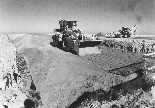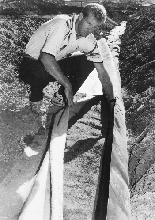


A better, less expensive way to cap hazardous waste landfills, particularly those in the arid Western United States, may be the outcome of a project being conducted by Sandia National Laboratories for the U.S. Department of Energy's landfill stabilization focus area .
 Sandia is conducting a large-scale demonstration
to test several alternative approaches to covering hazardous waste landfill sites. Covers
keep water out thereby preventing waste from leaching into the soil and groundwater below.
Sandia's work has been endorsed by the Western
Governors' Association Committee to Develop On-site Innovative Technologies.
Sandia is conducting a large-scale demonstration
to test several alternative approaches to covering hazardous waste landfill sites. Covers
keep water out thereby preventing waste from leaching into the soil and groundwater below.
Sandia's work has been endorsed by the Western
Governors' Association Committee to Develop On-site Innovative Technologies.
Current cover design criteria emphasize barrier layers that block infiltration of water through the cover into the waste. Saturated hydraulic conductivity is the measurement device chosen by the U.S. Environmental Protection Agency to define the effectiveness of the barrier layer. The lower the hydraulic conductivity, the better the layer is. This is not a practical solution in arid and semi-arid regions, because saturation of soil layers is rarely, if ever, achieved.
In arid climates, the saturated hydraulic conductivity method of evaluating covers renders them useless. After saturation, arid soils dry, shrink, and crack, creating potential pathways through the soil for water to reach hazardous materials within the landfill.
At many Western landfill sites, clay is not readily available. To comply with RCRA guidelines, many site operators must truck in a soil additive such as bentonite and mix it with native soil to create clay-like compaction characteristics. At a multi-acre site, this process can be a massive and costly undertaking and carries its own negative environmental side effects, such as large-scale excavation at the bentonite source and over-the-highway hauling demands.
DOE, with an estimated 3,000 landfill sites under its management, is interested in identifying more cost-effective and environmentally friendly ways to seal off each site as it reaches the end of its useful life. According to estimates developed at Los Alamos National Laboratory, the cost of installing a RCRA-approved cover can reach more than $2 million per acre in arid regions. Alternative covers evaluated during the project could provide superior performance and long-term reliability compared to the standard RCRA design, while costing significantly less to install and maintain.
Through the demonstration project, DOE aims to gain regulatory approval for use of alternative cover designs. RCRA guidelines stipulate that an approved alternative can be substituted for the standard cover design. Approval can come through the U.S. Environmental Protection Agency or through a state environmental agency where states have jurisdiction.
Sandia will conduct the five-year project in two phases. In the first phase completed
in fall 1995, three model landfill sites measuring 300 feet by 40 feet were constructed in
dry mesa country in one of Sandia's remote test areas south of Albuquerque, New Mexico.
The sites replicate three landfill cover types: a RCRA-standard municipal landfill site
cover (Subtitle D); a RCRA-sanctioned hazardous waste landfill cover (Subtitle C); and an
alternative hazardous waste landfill cover. The alternative design uses a manufactured  geosynthetic clay liner instead of the natural
two-foot clay layer stipulated in the RCRA guidelines. The geosynthetic clay liner is
engineered to block water passage far more effectively than a natural clay layer. During
the demonstration, the geosynthetic clay liner's performance will be compared to the
RCRA-approved liner.
geosynthetic clay liner instead of the natural
two-foot clay layer stipulated in the RCRA guidelines. The geosynthetic clay liner is
engineered to block water passage far more effectively than a natural clay layer. During
the demonstration, the geosynthetic clay liner's performance will be compared to the
RCRA-approved liner.
A number of innovative cover designs are being considered for testing and evaluation in Phase II. They include a dry barrier cover, in which air circulates in the cover layers to remove moisture; a capillary barrier method in which the capillary action of water impedes its migration from a higher, fine cover level to a lower, coarser level; and a so-called "enhanced evapotranspiration cover" that, through engineered vegetation design, enhances evaporation and plant transpiration, removing moisture from the soil.
Performance of these covers also will be compared against that of the RCRA-baseline cover design. Evaluation of the covers will be based on their respective construction costs, ease of construction, and physical performance. Half of each cover - a 150-foot by 40-foot section - will be evaluated under ambient conditions; the other half will be evaluated under stressed conditions where sprinkler systems will simulate precipitation. A sophisticated suite of instruments, some developed specifically for the project, will measure how effective the covers are in preventing water penetration.
![]()
![]()